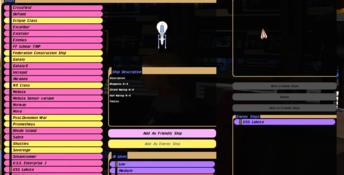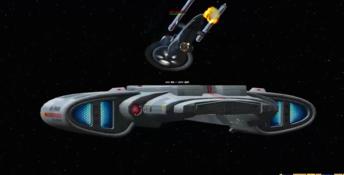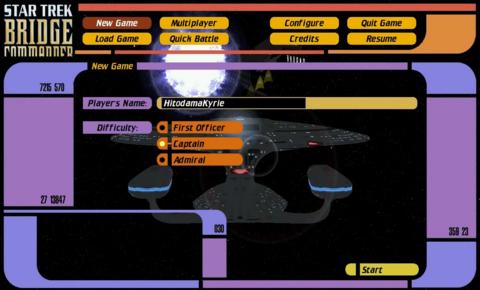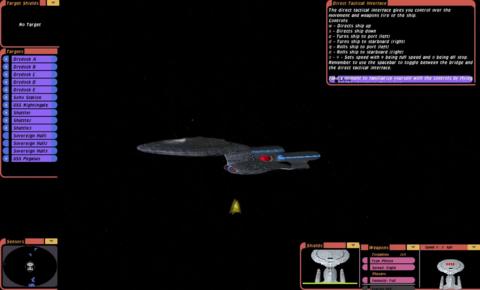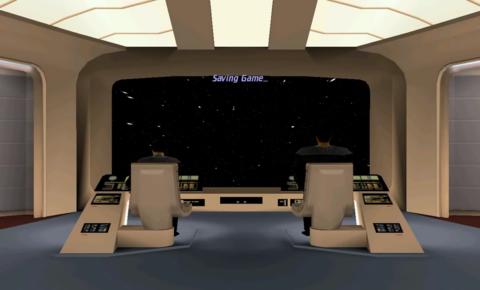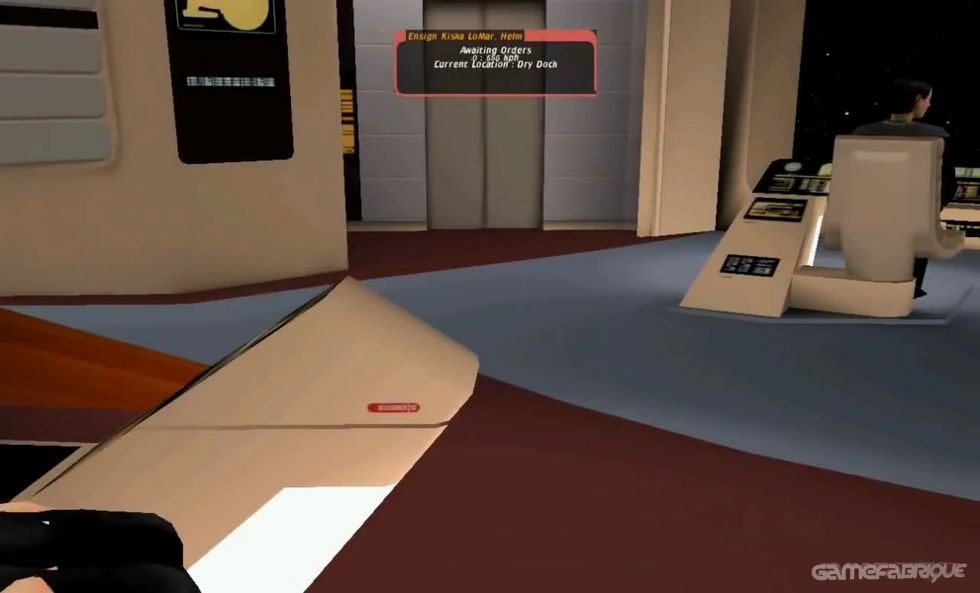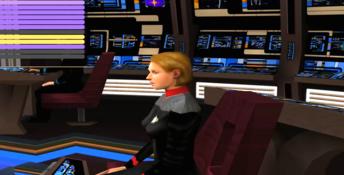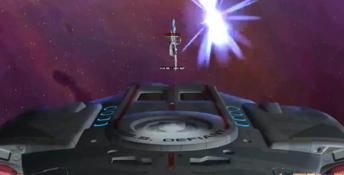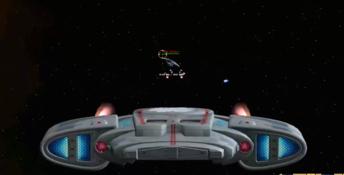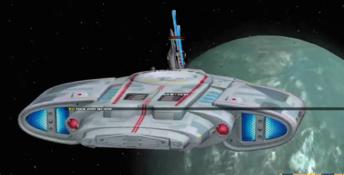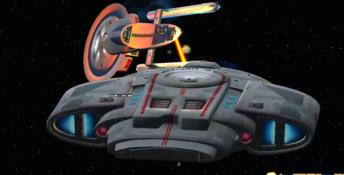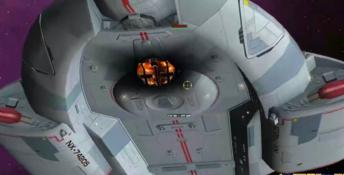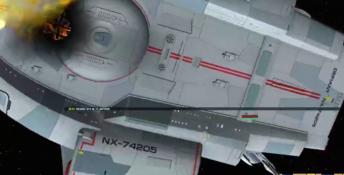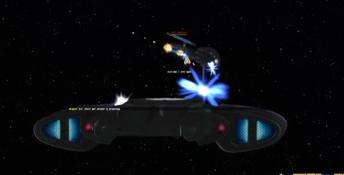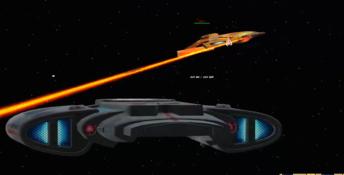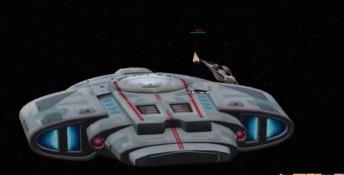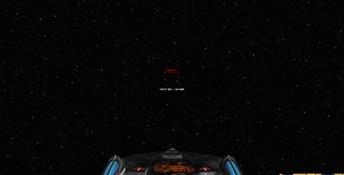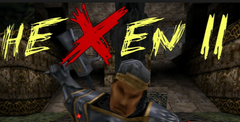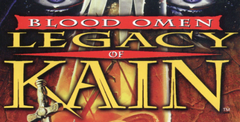Star Trek: Bridge Commander
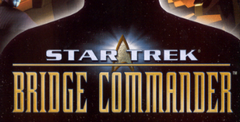
| a game by | Activision |
| Platform: | PC |
| Editor Rating: | 8/10, based on 1 review, 5 reviews are shown |
| User Rating: | 8.2/10 - 12 votes |
| Rate this game: | |
| See also: | Star Trek Games |
For a while back there, Bridge Commander\ooked like it was teetering on the edge of existence, as mumblings about quality control wafted about the PC games industry. However, it seems that Totally Games has got its act together, because Bridge Commander is showing signs of being a game to keep a watchful eye on, both for die-hard Trekkies and action/strategy fans alike.
Taking the captain’s seat you’ll have to order your crew members around to make your ship the ultimate intergalactic fighting machine. Your crew include a first and second officer, helmsperson and engineering officer. Totally Games claims the finished product will feature 'The most accurate ship models ever in a Star Trek space sim, painstakingly recreated with materials taken directly from Paramount Archives,’ which means fans can be assured of total authenticity.
Battles will be hugely reliant on tactical knowledge, with each ship having its own strengths and weaknesses which can be exploited to you or the enemy’s advantage. Totally Games eagerly boasts that each battle will provide 'Dramatic combat with large capital ships possessing significant firepower but limited manoeuvrability that will require smart weapon management and skillful manoeuvring to defeat your enemy.’ Star Trek fans should start getting excited now, because Bridge Commander is beginning to look more appealing than Seven of Nine in a skintight Lycra catsuit. Put it away...
Download Star Trek: Bridge Commander

System requirements:
- PC compatible
- Operating systems: Windows 10/Windows 8/Windows 7/2000/Vista/WinXP
Game Reviews
You never know quite where you are with humans, do you? Accidentally bump into one in a pub and whether you spill their pint or not, you can’t ever really tell what might happen, despite how close together their eyes or how pendulous their earlobes. Will they turn and put a friendly arm around you and embrace you as a long-lost brother, or will you be bundled onto the street to fight for your honour? Tricky beasts, humans.
If it were a bar on Deep Space Nine the problem would be much easier to circumvent. Spill a drop of your neighbour’s synthehol and all it takes is a quick glance at their facial features to plan your next move. Does he have engorged eyebrow ridges and giant ears? If so you’ve chanced across a Ferengi and they’ll probably demand a few bars of latinum in compensation, to which you just yank their lobes in a forceful manner and continue the evening (very sensitive part of the Ferengi anatomy, the ears). If they have cratered grey skin covered in bony nodules, then they’ll probably back off with a smile and stab you in the back when you go for a wee-wee. That’s the Cardissians for you.
Cornish pasty on forehead means you’ve just insulted an entire Klingon bloodline, so prepare for lengthy name-calling, followed by fisticuffs and marriage to his sister. Or if they are a Bajoran, where the skin between the eyes looks like it’s been pinched by a pair of pliers, you can just ignore them. The only non-human beings worth worrying about are the Borg, with their telling red beams of light scanning the room, in which case I would advise rotating your shield harmonics and making for a starship, preferably the Enterprise, since it always manages to scrape through the most dire of circumstances.
Young Enterprise
Funnily enough the USS Enterprise is where you begin your adventure in Bridge Commander, or rather the captain of Star Trek's most famous ship begins the game on your bridge, that of the USS Dauntless. Having lost your previous captain in an explosion in the Vesuvi system, you’ve been promoted to your first command and Picard is on hand to teach you the ropes while you in turn ferry him off to meet some Klingons. Needless to say that at some point, very soon after Picard is dropped off in actual fact, the universe needs to be saved and it's you rather than he that will have to do the saving, which is probably something of a relief for the man.
And so the real game begins, as Star Trek often does, with a series of mysterious attacks on a variety of ships, this time within and around a temperamental area of vacuum called the Maelstrom, which as it happens, the Vesuvi system is a part of. Your task then is to find out who is doing the attacking, why, and what the Vesuvi explosion has got to do with it. It's effectively the sci-fi equivalent of Goldilocks and the Three Bears, with you and your ship in turn asking who out of the Cardassians, Klingons and Romulans have been eating the porridge, and just like back at the bar at Deep Space Nine, it doesn’t take a genius to guess who’s behind the kerfuffle.
Chained By Command
Before reaping equal amounts of praise and vitriol on the game proper, let’s just say that while the story is perfectly acceptable Star Trek fare, the part you play in uncovering the predictable truth is so un-Sfar Trek that Bridge Commander might as well not be a Star Trek game at all. Effectively all you are doing is warping in to system after system, occasionally scanning the odd planet and usually blowing away all the ships you come across into dust. There would be nothing wrong with that if this was Wing Commander, Freespace, or indeed Star Wars, but being a Star Trek game it feels wrong that you never get the chance to bend a few rules and take matters into your own hands from time to time. Of course, the natural chain of command dictates that you follow orders and in turn your crew follow yours, but how many Star Trek captains do you know who follow every order to the letter? Answer: only the boring ones that no-one remembers.
What Bridge Commander needs are a few choices in the game; some opportunities to take short cuts, use some initiative, take a few risks or even disregard orders altogether if it means there is a chance of greater success further down the road. As it is, the game feels far too structured in that there is rarely more than one option open to you - which as I say is fine for a combat game, which this primarily is, but for that Star Trek dimension needs something extra - freedom to make decisions of your own outside the sphere of combat.
When Sparks Fly
The game is excessively linear but paradoxically because of this, Bridge Commander is a superb game, and one that has managed to capture the fluid nature of Star Trek's ship-to-ship combat like no computer game before. This is partly to do with the first-person view you get as you sit in the captain’s chair, as rather than watch a generic viewscreen from a faceless void, you sit among a crew that in game terms at least, is real. Simply move the mouse to look around and click the button to access a particular crew member’s station. It's this same feature that in B-17: The Mighty 8th made for such an engaging flight simulation; to actually see and interact with your crew made you more protective of them, even on a very crude and basic level, especially when you are placed in the world alongside them. In Bridge Commander’s case though, the crew are thrown about in typical Trek fashion; equipment starts sparking when the ship is under fire, but you never lose a crew member to injury - which is something of a missed opportunity (see box below). The main reason for Bridge Commander's success at transferring Star Trek's more static combat to the PC screen has to do with how the developer has handled the interface. In the past you might have controlled your ship by handholding your crew (in other words, you probably had to do everything yourself). Here however, you can pretty much leave them to it and issue orders whenever you see fit. It may sound like things are being taken out of your hands, but in actual fact it allows you to look at the bigger picture: keep an eye on other ships, re-allocate power settings and transfer repair crews to fix torpedo tubes if needed. Of course, you can take direct control of helm or tactical if you so wish; speed up, turn left (among other more exotic directions), target phasers and torpedos and so on. In fact, as the game progresses you sometimes do need to take over, but it never feels overwhelming (as it did in Klingon Academy),
especially if you have one of Microsoft’s GameVoice devices. You can use this to issue orders as they were meant to be - by the power of the spoken word, while keeping your digits free for other things.
Phaser Surgery
Certainly as the game grinds on, you will use the first-person bridge view less and less, and rely more on the outside camera views. You could argue at this point that the bridge view is nothing more than a gimmick and in a sense you’d be right. However, as I said, the bridge view is more than an interface -it’s how you get to know your crew and feel part of the game. Deep into the game however, it’s via the outside view that you’ll pull off the greatest victories, thanks to a target lock camera, where it’s as if you and your enemy are at either end of a taut rope, with your ship at the centre of the screen. Nothing ingenious there since it’s a staple feature of many flight simulations, but along with other camera modes it adds immeasurably to the cinematic feel of the combat, especially since the battles all take place in true 3D space, yet never, ever feel disorientating.
Certainly it helps things that Bridge Commander is a very attractive game, with the deep space backdrops, brushed with spiralling nebulae and clawed dust clouds adding depth and colour where typically there is none. The ships too look the part, especially in terms of scale as you manoeuvre out of a starbase after J some much-needed I repairs. But it’s during the battles that the game really comes to life, thanks in no small part to the fabulous graphical effects; fire your phasers at an enemy ship and his shields will glow as the energy is absorbed. The telling spikes of Photon torpedos arc convincingly through the void and inside the ships themselves the characters move and look fairly convincing, until they open their lips to show a frightening black space where teeth and gums should be - not pretty. The game does have other graphical oddities. Planets, though suitably gargantuan, are generally pretty dull to look at and damaged ships look like someone’s taken a bite out of a biscuit. It’s a shame the developers couldn’t have recreated the dancing arcs of electricity we sometimes see as the ships in the films are destroyed - certainly it’s a shame there are no really impressive explosions, or indeed instances in the game itself where you must quickly escape a ship counting down to self-destruct its warp engine, a la Wrath Of Khan.
Earl Grey, Hot
There are other niggles that are initially disappointing but soon lose importance. The music is repetitive, yet turn it off and the bridge becomes ominously silent thanks to a complete lack of background noise. Voices too can become jumbled as you quickly give out orders and everyone ends up speaking at the same time. Top of the league of little niggles however is the savegame feature, which in true console fashion, is automatic after every second or third mission. No doubt the game would be too easy if you could save whenever you wanted to, after every mission? Who knows, but as you can imagine, having fought to the end of a third successive battle only to lose it and go back to the beginning, is frustrating in the extreme. However, thanks to the addictive qualities of the battles, after a quick cup of Earl Grey I was back at the helm having forgotten the previous annoyance. Despite the ridiculous uniforms and grating political correctness of the TV shows, Star Trek has always been unrivalled in science fiction when it comes to offering a complete universe to get lost in. And while Bridge Commander is completely lacking in any L sense of freedom in terms of its story, it is probably the r fi nest exam pie of capital ship combat you’ll find on PC -Star Trek or otherwise - and probably one of the few Star Trek games over the years that has used the licence wisely. Like Raven’s Star Trek Voyager: Elite Force, Bridge Commander offers a thrilling ride, perfectly capturing the Star Trek universe though it unfortunately lacks the freedom of some of its TV episodes.
Missed Opportunity
If Only They’d Added...
Whether at the behest of Star Trek owners Paramount or a design decision, Bridge Commander suffers slightly in that none of your crew ever become injured. Yet throughout the course of the game, you will probably destroy more than 100 enemy ships (probably more than Kirk and Picard ever did combined). But why not kill off, or at least injure some of your crew? It would have added another dimension to the game. Say a grizzly doctor arrives on the bridge to take away your injured helmsman, you then have the problem of drafting in an understudy or taking over the station yourself. You could then add an RPG element to the proceedings... nothing too complicated, mind, but enough to add another level of interaction to the game. Ah well, maybe the sequel...
Despite only having a hundred or so regular online players. Bridge Commander is a game best played against a handful of opponents. Perhaps it's just as well, for although there is a mod that allows up to 16 people to fight it out across the emptiness of deep space, whether you want to or not, eight is the maximum and four the average - hardly what you might call all-out war. However, for a quick scrap, Bridge Commander is no less entertaining for it. Unfortunately finding a 'clean' game is something of a chore. Most servers are running mods, scripts or in some cases cheats and require you to download extra files, which is fine in the short term, but could mean you getting kicked out if you try joining another server which isn't running them. Some people get around this by installing two versions of the game; one where they allow extra downloads, another where they don't, but this doesn't get around the fact that Bridge Commander players have been left to their own devices and it's a community that could do with some policing.
That said, Bridge Commander online is just as good in combat as the single-player game. The interface and controls are identical and the thrill of destroying a real opponent much more satisfying (although be prepared for accusations of cheating if you win). Deathmatch, Team Deathmatch, Federation Vs Non Feds and Defend The Starbase are the four online modes and they're all a lot of fun. One minor quibble is that it's not uncommon to play against the same vessels time after time, which is fair enough as everyone wants to win so it helps to use the best ships on offer, but it's something the developers could have easily avoided by offering more mission objectives or limiting the numbers of a particular ship in a game.
More than most, Bridge Commander is a game best played against those you know and trust. As with Counter-Strike it's far too easy for cheats to prosper, unfortunately Bridge Commander doesn't have the numbers to sustain itself if those who want to play fair are turned away. Our advice is to play on a LAN, it's easier, faster and much, much safer.
There is eno potential her confusion. Bridge Com man coming your way from none other than Totally Games, the creator of the X-Wing series, I can see people looking at Bndge Commander and immediately thinking 'Star Trek meets X-Wing and bumps into Wing Commander along the wayfc Actually, no, you're wrong, stop thinking that please. Bridge Commander is in fact quite a unique take on the space combat genre. While just about every other space combat sim out there places you in the cockpit of a small fighter and sends you out to fight in open space, Bridge Commander places you in the driving seat of the huge Starships from the Next Generation universe, and gives you total control over each and every one of your crew. There is combat, but it's very tactical and unlike anything you've experienced before in a space combat sim. To get your head round this rather unusual concept, think of it as more of a simulation than an action game, a simulation of Federation captaincy, complete with all the trimmings, and with you in the captain's seat. It has to be said that the move away from frenetic space combat is a brave one on the part of Totally Games. It would have been easy for them to build on everything they've learned with" the X-Wing titles, and bring Star Trek fans the kind of first-class space combat sim that Star Wars fans have enjoyed for so long. As it stands, Bridge Commander relies more heavily on strategy than action for success in battle. It's an intriguing prospect, and it goes something like this...
Action Chess
Bridge Commander is essentially a freeform exploration game with large dollops of tactical combat. The development team is making great efforts to ensure that you are immersed in the game universe and familiarised with your crew before you even see battle, but sooner or later you will have a difference of opinion with one of the other races in the game. When this happens, you will go into combat mode. This is worth looking at in a fair amount of detail since it comprises a large proportion of the game. You can, if you wish, dive straight into battle at the first sign of conflict, but it makes more sense to go into tactical mode and look at your options. Your Tactical Officer will be on hand to give you all the information you need to prepare yourself for battle. He can give you an overview of the ship and the condition it's in, and is ready to carry out your battle orders. You can order him to carry out different battle manoeuvres, fire at will, or fire on your command. Basically, while you sit in your chair at the helm of the bridge, he does all the dirty work, but because he does only what you tell him to do, your actions have a direct bearing on the outcome of the battle. This approach to combat further emphasises how Totally Games wants you to feel you are in control of the ship and its crew, even in battle, rather than . encouraging you to jump straight in and mix it up with the enemy on a one-to-one basis. You can zoom in and take control of the ship and its weapons yourself, but chances are your expertise in this area will be somewhat lacking to start with, so you might want to get to know the game very well before proving your ineptitude in battle.
I have to admit, when the game was first demonstrated to me I was a little sceptical as to how engrossing this more casual approach to battle might be. But watching the development team play the game, it became clear that there is a lot to think about in the heat of battle. Knowing which weapons to use and when is paramount, as is timing and choosing which part of the enemy ship to attack. You can give very specific instructions as to exactly where you want your lasers to land on the enemy ship, weakening areas that are vital to its operation. You also have to keep an eye on all parts of your own ship and order repairs when necessary, transfer energy from strong areas to damaged ones, and manoeuvre the shin such a way that your weak side is not exposed to your enemy when you home in for the kill. As you ean see, there's a lot going on in the combat scenes, but unlike games such as X-Wing, Bridge Commander is quite slowpaced, and you will have plenty of time to make decisions in battle -you just have to hope are the right ones. It's not entirely dissimilar to submari combat in many respects, with the adversaries playing hide and seek and slowly weakening other's vessels from a distance. Expect some long battles in this game, particularly at later stages when the enemy ships are bigger and stronger and will take a lot of whittling down.
Peace, Man
That's not to say that the missions are all about picking on someone you don't like and blowing them up - in fact, most of them are quite the opposite. One of the missions we saw involved a conflict between the Klingons and the Romulans, both of whom believed they had been double-crossed by the other. In this situation, you don't want to kill either of them, but merely diffuse the situation. Peaceful negotiations are not an option here, you must play the diplomat by intercepting both ships and making sure they don't destroy each other in battle. This is achieved by ramming the ships and diverting them from their course. So while most of the game is primarily combat, there are missions that involve pure diplomacy, or searching and exploring inside nebulae. But most of the missions exist to drive along the story, which unfolds as you play the missions. Rather than sit through cut-scenes explaining the story before you jump into the action, the tale develops throd the actions of the races in the game during the missions, thus seamlessly blending the action and storyline anti giving the player a greater sense of immersion.
Your actions in the missions also determine how much further you progress in the game. If you don't get to places on time, achieve certain goals or prevent major conflicts, it's game over. Of course, you will also lose the game if your ship is blown to tiny pieces in battle: death has a habit of hampering further progress in most games and Bridge Commander is true to this tradition.
Gameplay is surprisingly free-flowing compared to the linear nature of most space combat sims, which simply give you one mission to complete after another. There are a number of things you can get on with at any given time. For example, if your ship is in a bit of a mess you can warp back to base for repairs assuming a) your warp engines have not been fried by enemy scum, and b) you have time to do it before your next mission is due to begin. You can also set about your given goals at any time in any order you see fit, again underlying the open-ended structure of the game and giving the player the feeling that he is immersed in a living universe rather than merely churning through one mission after another.
All In The Game
You could be forgiven for thinking at this point that the whole game is based on combat. While it's true that Bridge Commander is fundamentally a tactical combat game, there is enough going on between missions to provide a brief but much-needed diversion from all the head-scratching and decision making forced on the player in the combat scenes. Kvery event that takes place in the gameworld, which may or may not lead to missions, are related to you by the ship's crew, all of whom have unique dialogue for most given situations, and can provide detailed information on where you stand in the great scheme of things if called upon to do so. You will also have lengthy conversations with other races in the game, and you should pay attention to these before deciding whether to take action or assume a more diplomatic role in the proceedings. All of this serves to set the scene for the missions, perhaps in a much better way than the cut-scenes we are used to seeing before combat in most games of this type. Multiplayer should prove interesting too: you can only take control of the Sovereign or Galaxy ships in the single-player game, but in multiplayer you can take the helm of the ships belonging to other races. It will be interesting to see how players react to a more strategic multiplayer experience than they are probably used to.
Total immersion and strategic and challenging combat are the goals then for the Bridge Commander team, and if Totally Games can pull off its neatest trick to date, there is every possibility we will have a rather engrossing game on our hands, perhaps even a new genre. Could Bridge Commander possibly a return to strategic thinking after a long stream of mindless blasters? Probably not, but it's certainly a title that we will be following closely throughout its development cycle. Watch this space.
Battle Stations
Combat may be slower paced in Bridge Commander than in other space combat games, but it is no less spectacular.
Big ships mean big battles and, of course, big explosions. The combat sequences are a joy to watch, with visually stunning scenes such as this one being commonplace. Of course, if you watch the action from this viewpoint you are likely to miss something important happening on the bridge, such as vital bits of your ship falling off at the worst possible moments. You can't have everything.
Birth Of A Genre
A typical scene from Bridge Commander.
Note how you are watching the action as opposed to sitting in the thick of it. Bridge Commander is the first space combat game to favour tactical combat over frenetic dog-fighting action, and playing it feels very different from anything that's gone before. This particular scene is perhaps a little laid-back, you can go into full-screen mode to view the action if you wish, but the emphasis in this game is on tactics and if you don't communicate with your crew in the heat of battle you will soon find yourself up a certain creek. It's difficult at this stage to predict how well this type of combat will work without having played the game ourselves for any great length of time, but in theory the emphasis on strategy should make for a unique playing experience. All will no doubt be revealed when the game rolls In for review.
Overview
With the Dominion War now over and the Federation's place in the Delta Quadrant firmly established, many of the participants are still licking their wounds while the stability of the region is still questionable. For Cardassia's part in the war, the Federation and its allies have demanded the Cardassian's disband their fleet and cease production of military weapons but some still fear hidden fleets are being compiled and are insisting on more severe punishments against Cardassia. That's far from the end of the political problems plaguing the region unfortunately as the Klingons, Romulans, and the Federation are still working out the kinks in their new relationships (or lack of).
Star Trek Bridge Commander starts with an accident surrounding an area bordering Federation, Romulan, and Cardassian space. This region called the Maelstrom is mainly known for its inhospitable climate and although the borders surrounding it aren't clearly defined, rarely is there a confrontation due to its lack of appeal. With Federation scientists longing to study the phenomena, technology has finally advanced for terraforming to progress and a science station to be placed there. As first officer on a galaxy class starship, you begin by watching your captain get annihilated as a star goes super nova while he attempts to re-supply the engineers terraforming the planet. As you assume command and clear out before you too are destroyed, others also take notice and wonder, as does the Federation, at the cause of the sudden super nova.
Star Trek Bridge Commander is a flight simulator that attempts to capture the feel of these colossal starships as they engage enemies and fly through space. With most past attempts allowing the ships to feel more like small fighters, Bridge Commander stays true to the Star Trek universe and creates a system that accurately displays the maneuverability and tactical abilities of these giant battleships.
Gameplay, Controls, Interface
Star Trek has always been different from other sci-fi universes in the fact that these massive starships are the main line of defense. Others like Star Wars and most space simulators use small fighters as their primary weapon of choice, which are highly maneuverable and often extremely deadly. In the past, most Star Trek simulators ended up with colossal starships that flew like small fighters often disregarding the combat style and dependence on tactics that both the movies and television series showed.
Finally however, a game has been created that understands the physics of these massive starships and the movement they would be capable of. Instead of having the maneuverability of an F-15, they now move more like battleships, where having a battle plan becomes critical and protecting damaged portions of the ship or inflicting damage to specific areas of the enemy's ship become crucial. It can take one careless turn and the enemy will swing around to a weakened area of your shields and cause a serious amount of damage.
If you're not familiar with the Star Trek series, the starships really do act similar to battleships. On the starships the main weapon of choice is the phaser. Each phaser has a firing arc that allows a certain range of attack. For instance, most appear to have around a 70-degree range so phasers in the front of the ship couldn't fire at targets from behind. Phasers also cannot fire constantly and must be recharged, so getting behind an enemy and blasting them apart isn't going to happen unless you keep repositioning your ship to the phasers that are charged. Photon torpedoes are also available and cause more damage then the phasers. Due to their launch characteristics however, they are more accurate at distances and can track enemies only moderately well.
One other issue about combat that relates to the series is the ability to take out specific systems on enemy ships. Often you'd hear Picard order a stubborn enemy's weapons system destroyed or engines hit to either disable to give a tactical advantage in combat. This ability is also included in the game and adds a whole other dimension to combat tactics. When fighting a Romulan Warbird for instance, often they will cloak just when you get in position to give some serious damage and uncloak with their weapons arcs aimed at your weak spot. If the cloaking system is targeted and destroyed however, the advantage shifts since Warbirds are almost twice as big as the largest Federation's ships and are less maneuverable.
Although the ships do move and have similar combat abilities to the series, if the ship isn't easily controlled, it can be an extremely frustrating experience. As the name implies, the ship is controlled using a similar manner that Starfleet Captains utilize. To control the ship, the first officer, helm, tactics, science station, and engineering are available and ready to receive orders. Especially with the helm and tactics, direct control can also be taken for weapons and piloting but if you're more of an armchair captain, orders can be given to let the helm pilot and tactics control the weapons. There can be some advantage to this however as battles often require attention to be split between different areas. Engineering for instance often needs guidance adjusting the power output to different systems so if the shields are taking a beating, more power can be sent there or if your phasers aren't recharging fast enough, power can be increased there as well. Allowing the helm to pilot or tactics to control the weapons is especially useful in the early stages of the game as the interface and control systems are still being worked out. Once you get comfortable, the tactical view from the outside of the ship will be the view of choice as you control the piloting, weapons, and all other systems with ease, requiring little help from your crew.
Besides the campaign, there is also a quick battle option available. Here any of the starships encountered can be flown but the bridge is restricted to either the Galaxy or Sovereign class Federation ships. Similar to most quick battles for simulators, friends and enemies can be selected along with location for encounters of any type. In addition, by flying other types of ships, you can get a better feel of their strengths and weaknesses when they are encountered in the campaign.
Graphics
There are definitely two sides to the graphics: the bridge and tactical view. From the tactical view, or view from outside the starship, the graphics are astounding. The starships are beautifully detailed with a level of accuracy that is well above anything I've seen for Star Trek. Although the explosions could have been better, the ships do show damage and even break apart realistically. The bridge on the other hand has some shortcomings. The main issue isn't with the actual bridge, but mainly with the crew. Basically, they look pretty bad but when talking, it's even worse as their mouths are out of sync with their voices. The good news however is that once you become conformable with the interface and controls, the bridge is rarely used.
Audio
There isn't much to say about the audio except it holds true to the movies and series. Patrick Stewart and Brent Spiner even add their voices for Picard and Data, adding to the realism. Other effects like phaser fire and photon torpedo launches all sound perfect.
System Requirements
3-D Hardware Accelerator (with 16MB VRAM), US version of Microsoft Windows 95 OSR2/98/ME/2000/XP operating system, Pentium II 300Mhz processor (Pentium II 450Mhz processor recommended) or Athlon processor, 64MB RAM, 650 MB of uncompressed hard disk space for game files; plus an additional 100 MB for Windows swap.
Bottom Line
Star Trek Bridge Commander is a game that fans of the series will really appreciate. In addition to a great story line, the attempt to stay true to the series pays off with a solid space simulator accurately portraying these massive ships in both movement and tactics. For those not overly impressed with Star Trek in general, there are still a number of reasons to purchase this game and most will be impressed. Although there are some issues with the bridge crew, Bridge Commander is a well-balanced space simulator that will spend some time on your hard drive.
